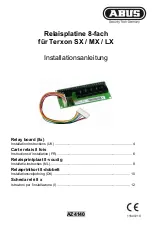
CHAPTER 3: IEC 61850 COMMUNICATION
OVERVIEW
UR FAMILY – COMMUNICATIONS GUIDE
3-5
3
an implementing logical node is required to contain, and which data objects an implementing logical node can optionally
contain. A logical node class also defines the name and CDC of each of its data objects. IEC 61850 7-4:2010 clause 6
defines the semantic of standard data object names. For instance, the Instantaneous overcurrent logical node class, which
has class name PIOC, requires an Op data object with the following CDC Protection activation information (ACT) and
semantic:
"Operate (common data classes ACT) indicates the trip decision of a protection function (LN). The trip itself is issued by
PTRC."
Logical node class PIOC also requires the mandatory data object Beh (Behaviour, meaning on, off, test, and so on) and
permits the optional data objects Str (Start), OpCntRs (Resettable operation counter), StrVal (Start value setting) and several
others from the common logical node class. It is possible for a device manufacturer to add data objects in addition to
those specified by a logical node class, but the expansion rules in IEC 61850 7-1:2011 clause 14 must be followed. The UR
family devices in fact do extend the standard logical nodes in many cases; the data objects implemented are as tabulated
in clause 3.4 MICS.
Logical node names are required to be formed from the four-character logical node class name that it implements, a prefix
text, and a suffix instance number. An example is PhsIocPIOC1, in which "PIOC" is the implemented logical node class
name, "PhsIoc" is the prefix, and "1" is the instance number. UR devices adopt the convention that the prefix identifies the
UR element that the logical node is used to model, and the instance number is the UR element number. For instance, all
logical nodes used to model the AC sources use the prefix ACsrc. The logical nodes used to model AC source 1 have logical
node instance 1, the logical nodes used to model AC source 2 have logical node instance 2, and so on. Thus the names for
logical nodes modelling AC source 1 are ACsrcMMXU1, ACsrcMMXN1, and ACsrcMSQI1. Prefixes and instance numbers are
fixed in UR devices, except that three special logical nodes can have user configurable prefixes (GGIO1, GGIO2, and GGIO4).
A collection of related logical nodes are combined into an entity at the next level up in the hierarchy known as a Logical
Device. Logical devices are required to have one logical node implementing logical node LLN0, which addresses common
issues for the containing logical device. Logical devices can also contain as many logical nodes as desired. UR devices of
this release initially have six logical devices, with logical node instance names and contained logical nodes as generally
described in the following table, but can be reconfigured to have from 1 to 16 logical devices. The logical device to which
each logical node is assigned initially is as specified in clause 3.4 MICS, but except for the logical nodes shown there in
logical device Master, logical nodes can be moved to any logical device. The assignment of logical nodes to logical devices
is configurable, as is the number of logical devices from 1 to 16.
Table 3-1: Factory default logical nodes
Logical devices have a product-related name and optionally a function-related name. The product-related name consists
of the logical device instance name (see table) prefixed by the configured IED name. Other than the product-related name
of the logical device "Master," both the product-related name and the function-related name are freely configurable,
although the standard strongly recommends use of the IEC 81346 series for the derivation of function related name. The
function-related names are used only when configured by the user, and then only in communications, not in Substation
Configuration Language (SCL). The product-related name is used in SCL, and when no function-related name is configured,
in communications. Note that the symbol "LDName" is used in standard documents to represent either the function-
related or product-related name as appropriate to the context, while "ldName" is used to define the function-related
name. Upper/lower case is critically significant in many 61850 names.
Logical device instance
name
Generally contains logical nodes modelling…
Master
communications, including GOOSE, reports, Remote I/O, Virtual Inputs, Modbus, DNP, and setting group
control
Prot
protection and protection-related functions
Ctrl
control and monitoring functions
System
power system devices: breakers, switches, CTs, VTs, and so on, including interfaces to these, such as AC
inputs, contact I/O, transducer I/O, HardFiber I/O
Meter
metering and measurement (other than PMU), including AC sources
Gen
FlexLogic, Virtual Outputs, non-volatile latches, FlexElements, recording (for example oscillography), security,
front panel, clock
















































